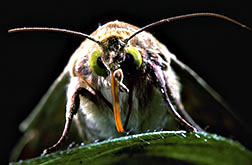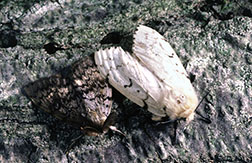Tracing Moth Migrations
|
|
Knowing the travel patterns of these mobile pests can help growers plot effective controls.
Former Agricultural Research Service entomologist Douglas C. Ferguson (now retired) spent a half century tracking moth species across the continent.
Knowledge of a moth's frequent-flier mileage can influence the timing of pest control measures—especially components of integrated pest management programs. And timing's becoming increasingly critical as control strategies need to cross county and state lines to deal with these mobile pests.
“Many of the moth species that make up the insect order Lepidoptera are serious pests affecting crops and forests,” says Ferguson. “These include corn earworms, Helicoverpa zea, as well as armyworm, Pseudoletia unipuncta, tobacco budworm, Heliothis virescens, and fall armyworm, Spodoptera frugiperdia. “Though these are among the most costly U.S. insect pests to control,” he says, “many other moths are useful in helping to control weeds.”
A world expert on Lepidoptera, Ferguson still works on gypsy moths and inchworm moths at ARS’ Systematic Entomology Laboratory as a taxonomist, searching for ways to tell moth species apart.
During his career, he has collected over 200,000 moth museum specimens in the United States and Canada. They are now part of the national collection of insects at the U.S. National Museum of Natural History in Washington, D.C.
Largely as a byproduct of his research, Ferguson has been accumulating and analyzing data on the migratory moths of eastern North America since the 1960’s.
To collect specimens, Ferguson ties a white bedsheet between two trees and shines a light on it—usually an ultraviolet fluorescent or mercury vapor lamp. The illuminated sheet attracts the moths without damaging them, leaving them in good condition for examination. Ferguson has spent thousands of nocturnal hours doing just this. Sometimes he also sets out light traps or applies fermented fruit and sugar bait to tree trunks.
"The bait technique has been used since the 1830's and is still one of the best," he says.
As a graduate student in the 1960’s, Ferguson got the idea that moths migrate unbelievably long distances and wrote a term paper on the subject. He says this early training alerted him about what to look for in doing this migration research.
"I needed to know enough about moths in general—not only the pests—to do moth migration research," he says.
In the United States, there are more than 11,000 moth species. Ferguson categorizes them all, including the economically important ones, into two groups: migratory and nonmigratory. Unlike butterflies, most moths fly at night, so their migrations have long remained a secret.
"Our understanding of this aspect of their behavior has developed very slowly," he says.
Assisted by the right wind and weather conditions, some migratory species can cover at least 600 miles in one nonstop flight. Evidence is ample that a few have flown much farther than that.
Nonmigratory moths do not expose themselves to transport by major weather systems and are thought to be more sedentary—perhaps wandering only a few miles per year.
Ferguson devised ways to shed more light on both styles of dispersal.
 Corn earworm moth, Helicoverpa zea. (K1510-19) |
For example, from his years of field detective work and using the museum’s extensive moth collections, he determined which are the long-range migratory moths of eastern North America. To verify his assumptions, he then investigated the moth fauna of Bermuda, using the islands 600 miles from Cape Hatteras, North Carolina, as a natural laboratory.
He thought that "if most of the migrants of the East Coast are also present in Bermuda, then the most likely explanation is that they can fly there," he says. This hypothesis was further substantiated by data from other islands worldwide. In 1991, Ferguson published a detailed account of those findings.
"Of the 40 migratory pest species that occur in the eastern United States," he says, "38 are now reported from Bermuda."
Previously, it had been suggested that some of these were unintentionally taken to Bermuda by people. But Ferguson questioned why such a disproportionate number of migratory species would be introduced there accidentally.
As to why moths fly so far, Ferguson says that “migrants not only exploit new food sources, they also evade predators, parasites, and diseases that have no way of catching up with them. Their one long flight is probably related to favorable winds that tend to carry them northward in spring and summer and southward in fall—that, coupled with their basic urge to ensure species survival.
Ferguson believes that moths fly quite high, taking advantage of low level jet streams. These currents can carry them up to 68 miles per hour, at a height of 1,000 to 3,000 feet, for many hours.
But sometimes the weather betrays the moths and carries them far off course over the Atlantic or too far north to breed successfully.
Monitoring the Slow Movers
More recently, Ferguson turned his attention to finding out the travel distances of more sedentary moths—the nonmigrants. However, this proved more difficult.
The only way seemed to be to measure the rates of spread of introduced species. So Ferguson investigated the case histories of 10 foreign moth species for which sufficient information was available. These included the potato stem borer, Hydraecia micacea Esper, and the large yellow underwing (cutworm), Noctua pronuba L.
He established for the first time how far these nonmigratory insects had spread and the average rate of movement per year for a known timespan. Until then, only the gypsy moth, Lymantria dispar, had been examined in this regard.
“Studying how introduced species spread gives you a starting point, and knowing how far they travel gives you a hint as to what to expect if a new pest should invade the country,” says Ferguson.
“Two cutworm moths were the fastest spreading of the accidentally introduced moth species,” he says. “One champion traveler appears to have spread 121 miles in a year and the other, 99 miles in one continuous flight—over water.” These pests attack a wide variety of garden, crop, and weed plants.
Ferguson found that other introduced species spread from 8 to 28 miles a year. Of the 10 foreign moth species he studied, the European gypsy moth spread the slowest—an overall average of about 8 miles a year, since being introduced around 1868. This was probably because of its flightless females. The browntail moth, Euproctis chrysorrhoea, and satin moth, Leucoma salicis, which are in the same family but with flying females, spread much faster—about 26 and 28 miles per year.
Ferguson estimates that the time required for various nonmigrant, introduced species to occupy all suitable habitat in the United States and Canada varies from 30 to 100 years. “Yearly mileage totals may vary,” he says, “for moths rarely fly in a straight line. Most of their flights are in a zigzag pattern.
“And, curiously,” he adds, “6 of the 10 Eurasian immigrants studied entered the United States independently, from both East and West coasts. Seaports, rather than airports, have been the major points of entry.”
Nearly all accidentally introduced Lepidoptera—an estimated 125 species—are of European origin.
Like most of the ARS Systematic Entomology Laboratory entomologists, Ferguson is located at the U.S. National Museum of Natural History. The laboratory maintains headquarters and part of its staff at the Beltsville (Maryland) Agricultural Research Center. — By Hank Becker, ARS.







